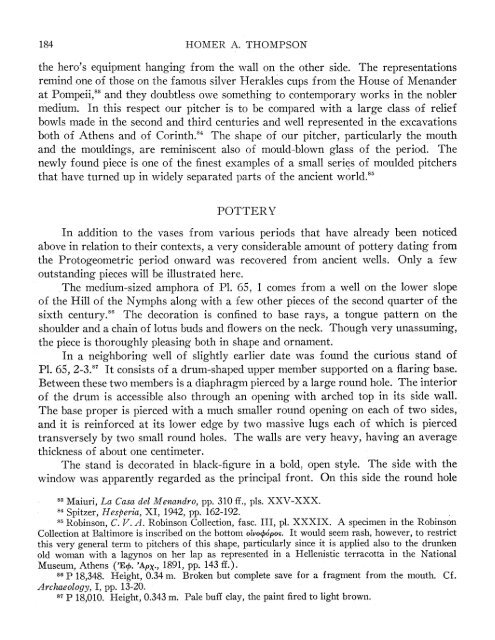the excavation of the athenian agora twelfth season: 1947
the excavation of the athenian agora twelfth season: 1947
the excavation of the athenian agora twelfth season: 1947
You also want an ePaper? Increase the reach of your titles
YUMPU automatically turns print PDFs into web optimized ePapers that Google loves.
184 HOMER A. THOMPSON<br />
<strong>the</strong> hero's equipment hanging from <strong>the</strong> wall on <strong>the</strong> o<strong>the</strong>r side. The representations<br />
remind one <strong>of</strong> those on <strong>the</strong> famous silver Herakles cups from <strong>the</strong> House <strong>of</strong> Menander<br />
at Pompeii,83 and <strong>the</strong>y doubtless owe something to contemporary works in <strong>the</strong> nobler<br />
medium. In this respect our pitcher is to be compared with a large class <strong>of</strong> relief<br />
bowls made in <strong>the</strong> second and third centuries and well represented in <strong>the</strong> <strong>excavation</strong>s<br />
both <strong>of</strong> A<strong>the</strong>ns and <strong>of</strong> Corinth.84 The shape <strong>of</strong> our pitcher, particularly <strong>the</strong> mouth<br />
and <strong>the</strong> mouldings, are reminiscent also <strong>of</strong> mould-blown glass <strong>of</strong> <strong>the</strong> period. The<br />
newly found piece is one <strong>of</strong> <strong>the</strong> finest examples <strong>of</strong> a small series <strong>of</strong> moulded pitchers<br />
that have turned up in widely separated parts <strong>of</strong> <strong>the</strong> ancient world.85<br />
POTTERY<br />
In addition to <strong>the</strong> vases from various periods that have already been noticed<br />
above in relation to <strong>the</strong>ir contexts, a very considerable amount <strong>of</strong> pottery dating from<br />
<strong>the</strong> Protogeometric period onward was recovered from ancient wells. Only a -few<br />
outstanding pieces will be illustrated here.<br />
The medium-sized amphora <strong>of</strong> P1. 65, 1 comes from a well on <strong>the</strong> lower slope<br />
<strong>of</strong> <strong>the</strong> Hill <strong>of</strong> <strong>the</strong> Nymphs along with a few o<strong>the</strong>r pieces <strong>of</strong> <strong>the</strong> second quarter <strong>of</strong> <strong>the</strong><br />
sixth century.86 The decoration is confined to base rays, a tongue pattern on <strong>the</strong><br />
shoulder and a chain <strong>of</strong> lotus buds and flowers on <strong>the</strong> neck. Though very unassuming,<br />
<strong>the</strong> piece is thoroughly pleasing both in shape and ornament.<br />
In a neighboring well <strong>of</strong> slightly earlier date was found <strong>the</strong> curious stand <strong>of</strong><br />
P1. 65, 2-3.87 It consists <strong>of</strong> a drum-shaped tipper member supported on a flaring base.<br />
Between <strong>the</strong>se two members is a diaphragm pierced by a large round hole. The interior<br />
<strong>of</strong> <strong>the</strong> drum is accessible also through an opening with arched top in its side wall.<br />
The base proper is pierced with a much smaller round opening on each <strong>of</strong> two sides,<br />
and it is reinforced at its lower edge by two massive lugs each <strong>of</strong> which is pierced<br />
transversely by two small round holes. The walls are very heavy, having an average<br />
thickness <strong>of</strong> about one centimeter.<br />
The stand is decorated in black-figure in a bold, open style. The side with <strong>the</strong><br />
window was apparently regarded as <strong>the</strong> principal front. On this side <strong>the</strong> round hole<br />
83 Maiuri, La Casa del Menandro, pp. 310 if., pls. XXV-XXX.<br />
84 Spitzer, Hesperia, XI, 1942, pp. 162-192.<br />
85 Robinson, C. V. A. Robinson Collection, fasc. III, pl. XXXIX. A specimen in <strong>the</strong> Robinsol<br />
Collection at Baltimore is inscribed on <strong>the</strong> bottom otvoqo'po3. It would seem rash, however, to restrict<br />
this very general term to pitchers <strong>of</strong> this shape, particularly since it is applied also to <strong>the</strong> drunken<br />
old woman with a lagynos on her lap as represented in a Hellenistic terracotta in <strong>the</strong> National<br />
Museum, A<strong>the</strong>ns ('E+. 'ApX., 1891, pp. 143 ff.).<br />
86 p 18,348. Height, 0.34 m. Broken but complete save for a fragment from <strong>the</strong> mouth. Cf.<br />
Archaeology, 1, pp. 13-20.<br />
87 p 18,010. Height, 0.343 m. Pale buff clay, <strong>the</strong> paint fired to light brown.

















